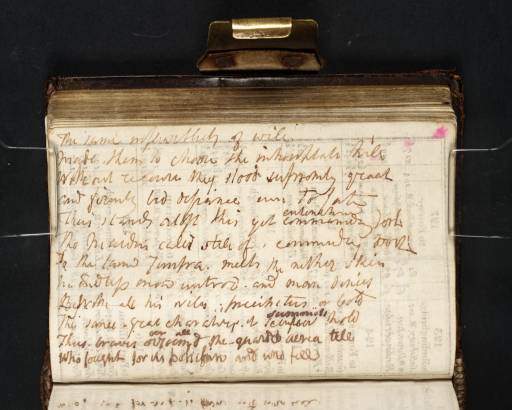Joseph Mallord William Turner Inscription by Turner: Draft of Poetry 1811
Joseph Mallord William Turner,
Inscription by Turner: Draft of Poetry
1811
Joseph Mallord William Turner 1775–1851
Folio 98 Verso:
Inscription by Turner: Draft of Poetry 1811
D08550
Turner Bequest CXXIII 95a
Turner Bequest CXXIII 95a
Inscribed by Turner in ink (see main catalogue entry) on white wove printing paper, 75 x 117 mm
Part watermark ‘W Di’
Part watermark ‘W Di’
Accepted by the nation as part of the Turner Bequest 1856
References
1862
Walter Thornbury, The Life of J.M.W. Turner, R.A. Founded on Letters and Papers Furnished by his Friends and Fellow-Academicians, London 1862, vol.II, p.25.
1897
Walter Thornbury, The Life of J.M.W. Turner, R.A. Founded on Letters and Papers Furnished by his Friends and Fellow-Academicians: A New Edition, Revised with 8 Coloured Illustrations after Turner’s Originals and 2 Woodcuts, London 1897, pp.213–14.
1909
A.J. Finberg, A Complete Inventory of the Drawings of the Turner Bequest, London 1909, vol.I, p.348, CXXIII 95a, as ‘Verses’.
1966
Jack Lindsay, The Sunset Ship: The Poems of J.M.W. Turner, Lowestoft 1966, p.116.
1990
Andrew Wilton and Rosalind Mallord Turner, Painting and Poetry: Turner’s ‘Verse Book’ and his Work of 1804–1812, exhibition catalogue, Tate Gallery, London 1990, pp.172–3.
The whole page is taken up with the following lines of verse:
The same inflexibility of will
Made them to choose the inhospitable hill
Without recourse they stood supremely great
And firmly bid defiance even to Fate
Thus stands aloft this yet commanding [?‘entrenched’ inserted above] fort
The Maiden called still of commanding [‘fort’ or ‘port’]
So the famd Junfra [i.e. ‘Jungfrau’] meets the nether skies
In endless snow untrod and man denies
<By> With all his wiles precipitus or bold
The same great characters of Simplon [‘summits’ inserted above] hold
Thus [?Graves around] [‘oer all’ inserted above] the guarded area tell
Who fought for its possession and who fell1
Made them to choose the inhospitable hill
Without recourse they stood supremely great
And firmly bid defiance even to Fate
Thus stands aloft this yet commanding [?‘entrenched’ inserted above] fort
The Maiden called still of commanding [‘fort’ or ‘port’]
So the famd Junfra [i.e. ‘Jungfrau’] meets the nether skies
In endless snow untrod and man denies
<By> With all his wiles precipitus or bold
The same great characters of Simplon [‘summits’ inserted above] hold
Thus [?Graves around] [‘oer all’ inserted above] the guarded area tell
Who fought for its possession and who fell1
Interspersed with drawings and the printed pages of Coltman’s British Itinerary, sixty-nine pages of this sketchbook are given over wholly or partly to these verses which Turner intended as a commentary for publication with the Picturesque Views on the Southern Coast of England which he sketched on the 1811 West Country tour (see the introduction to the sketchbook). The first lines are on folio 18 verso (D08396), and the last on folio 207 verso (D08736; CXXIII 204a).
Turner first mentions Maiden Castle, the Iron Age Dorset hill fort, on folio 90 verso (D08534; Turner Bequest CXXIII 87a), where he wrongly wrote of its being a Roman site; he then considered Regulus as an exemplar of Roman virtue on folio 93 verso (D08540; CXXIII 90a), before returning to the fort here, the ‘them’ of the second line being its supposed Roman originators. He then compares the hilltop setting with the Jungfrau, the Swiss mountain he first drew in 1802 in the St Gothard and Mont Blanc sketchbook (Tate D04631; Turner Bequest LXXV 39) and the Lake Thun sketchbook (Tate D04727; Turner Bequest LXXVI 67), and the Simplon Pass to its south.
In the last two lines Turner seems to refer to the graves of ancient warriors in the Maiden Castle area, continuing with this theme on folio 103 verso (D08559; CXXIII 100a). Wilton and Turner’s suggestion of ‘entrenched’ for the first superscription seems correct; Thornbury’s less likely suggestion being ‘encinctured’ (girdled or enclosed). They suggest ‘braves’ in the penultimate line where Thornbury and Lindsay give ‘graves’, though neither reading is certain.
Matthew Imms
June 2011
See transcriptions (followed here with slight variations) in Lindsay 1966, p.116, the last two lines as part of ‘Maiden Castle and Barrows’, section (m) of poem no.50, ‘On the Western Itinerary 1811’, and Wilton and Turner 1990, pp.172–3; previously transcribed with variations in Thornbury 1862, II, p.25 and 1897, p.213–14.
How to cite
Matthew Imms, ‘Inscription by Turner: Draft of Poetry 1811 by Joseph Mallord William Turner’, catalogue entry, June 2011, in David Blayney Brown (ed.), J.M.W. Turner: Sketchbooks, Drawings and Watercolours, Tate Research Publication, December 2012, https://www

